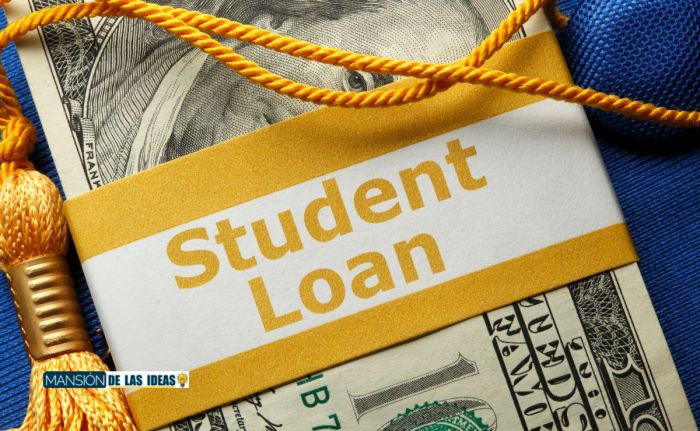
The resumption of student loan interest payments marks a significant turning point for millions of borrowers and the broader economy. After a period of forbearance, the financial implications are far-reaching, affecting not only individual borrowers’ budgets but also national economic indicators such as consumer spending and GDP growth. Understanding the multifaceted impact of this change is crucial for both policymakers and individuals navigating the complexities of student loan debt.
This analysis delves into the potential economic ripple effects, examining the projected burden on borrowers with varying loan amounts and repayment plans. We will explore government responses, the role of lending institutions, and the long-term implications for higher education affordability and future borrowing behavior. The goal is to provide a comprehensive overview of this pivotal moment in the student loan landscape.
The Economic Impact of Resuming Student Loan Interest
The resumption of student loan interest payments after a period of forbearance will undoubtedly have a significant impact on the US economy. Millions of borrowers will face renewed monthly expenses, potentially leading to decreased disposable income and altered spending habits. This ripple effect will reverberate through various sectors, influencing consumer spending, overall economic growth, and inflation rates. Understanding the potential magnitude of these changes is crucial for policymakers and economists alike.
Ripple Effects on Consumer Spending
The resumption of student loan payments will directly reduce the disposable income of millions of borrowers. This reduction will likely lead to decreased consumer spending, particularly on discretionary items like entertainment, travel, and dining out. The magnitude of this decrease will depend on factors such as the size of individual loan payments, borrowers’ existing debt levels, and their overall financial situations. For example, a borrower with a significant loan balance and limited savings may drastically curtail spending, while a borrower with a smaller loan and substantial savings may experience a less pronounced impact. This shift in consumer behavior could negatively affect businesses reliant on consumer spending, potentially leading to reduced sales and potentially impacting employment in those sectors.
Projected Impact on GDP Growth and Inflation
The reduced consumer spending resulting from resumed loan payments is projected to negatively impact GDP growth. Decreased demand for goods and services will likely translate into slower economic expansion. The precise magnitude of this impact is difficult to predict with certainty and depends on several factors, including the overall health of the economy and the responsiveness of businesses to reduced demand. Furthermore, the resumption of payments could exert upward pressure on inflation, at least in the short term. This is because the decreased consumer demand might not immediately translate into lower prices, especially if businesses are slow to adjust their pricing strategies. However, in the long run, reduced demand might lead to a dampening effect on inflation.
Comparison to Previous Periods of Similar Economic Conditions
The economic consequences of resuming student loan interest payments can be compared to previous periods of economic stress, such as the Great Recession. During the Great Recession, a significant decline in consumer spending contributed to a sharp contraction in GDP. While the current economic climate differs from that of the Great Recession, the resumption of student loan payments introduces a similar element of reduced disposable income and potential decline in consumer spending. However, unlike the Great Recession, the current economic conditions are characterized by strong employment numbers and relatively low unemployment rates. This makes predicting the exact economic impact more complex, as the existing economic strength might mitigate some of the negative consequences of reduced consumer spending.
Projected Changes in Key Economic Indicators
The following table presents projected changes in key economic indicators under different scenarios of student loan interest payment resumption. These projections are based on various macroeconomic models and are subject to considerable uncertainty.
| Scenario | GDP Growth (%) | Inflation (%) | Consumer Spending (%) |
|---|---|---|---|
| Baseline (gradual resumption) | -0.5 to -1.0 | 0.2 to 0.5 increase | -1.0 to -1.5 |
| Aggressive Resumption | -1.0 to -1.5 | 0.5 to 1.0 increase | -1.5 to -2.0 |
| Phased Resumption with Support | -0.2 to -0.5 | 0.1 to 0.3 increase | -0.5 to -1.0 |
Impact on Student Borrowers

The resumption of student loan interest payments will significantly impact borrowers across the board, creating a renewed financial strain for many. The severity of this impact will vary depending on individual loan amounts, repayment plans, and overall financial situations. Understanding these diverse effects is crucial for assessing the broader economic consequences.
The financial burden will be disproportionately felt by borrowers with larger loan balances and those on income-driven repayment (IDR) plans. For example, a borrower with a $100,000 loan balance will accrue significantly more interest than someone with a $20,000 loan, even with the same interest rate. IDR plans, while designed to make payments more manageable, often result in longer repayment periods, leading to a greater accumulation of interest over time. This means that even small interest accruals can compound significantly over the loan’s lifespan, potentially increasing the total amount owed by thousands of dollars.
Financial Strain and Competing Obligations
The added cost of interest payments will force many borrowers to make difficult choices regarding their finances. For instance, a borrower who was previously able to comfortably meet their rent, utility bills, and other essential expenses might find themselves struggling to balance these obligations with the reinstated interest payments. This could lead to reduced spending on necessities, delaying or forgoing medical care, or even falling behind on other crucial debts. A single parent struggling to make ends meet might have to cut back on childcare, impacting their ability to work and further exacerbating their financial situation. Others may be forced to choose between making student loan payments and paying for groceries or other essentials.
Increased Defaults and Delinquencies
The resumption of interest payments is likely to lead to a rise in student loan defaults and delinquencies. As borrowers face increased financial pressure, many will struggle to keep up with their payments. This is particularly true for those who were already experiencing financial hardship before the interest pause. For instance, the economic fallout from the COVID-19 pandemic left many borrowers unemployed or underemployed, making it difficult to manage their loan repayments even without interest. The added burden of interest could push many of these individuals into default, resulting in negative impacts on their credit scores and potentially leading to wage garnishment or other legal actions. A study by the Brookings Institution, for example, projected a significant increase in delinquencies following the resumption of payments, highlighting the potential for a widespread financial crisis among student loan borrowers.
Resources for Borrowers
The government and various non-profit organizations offer resources to assist borrowers struggling with student loan payments. It is crucial for borrowers to explore these options proactively.
- Federal Student Aid Website: This website provides information on repayment plans, income-driven repayment options, and other forms of assistance.
- Student Loan Counseling Services: Several non-profit organizations offer free student loan counseling services to help borrowers understand their options and create a repayment plan that works for them.
- National Foundation for Credit Counseling (NFCC): The NFCC provides credit counseling and debt management services, including assistance with student loans.
- Your Loan Servicer: Contact your loan servicer to discuss your options and explore potential hardship programs or deferments.
Government Policies and Responses

The resumption of student loan interest payments has prompted various government responses aimed at mitigating the potential financial hardship on borrowers. These policies range from modifications to existing repayment plans to the introduction of new support programs, reflecting a diverse approach to managing the issue across different nations. Understanding these policies is crucial for assessing their effectiveness and identifying potential areas for improvement.
Existing Student Loan Repayment Program Modifications
The United States, for example, has historically offered several income-driven repayment (IDR) plans, such as the Revised Pay As You Earn (REPAYE), Income-Based Repayment (IBR), and Income-Contingent Repayment (ICR) plans. Following the pause on student loan interest and payments, the Biden administration explored extending and potentially improving these existing IDR plans. Modifications might include lowering the percentage of discretionary income allocated to loan repayment, extending the repayment period, or offering more forgiving terms for borrowers struggling to make payments. These changes aim to make repayments more manageable without significantly increasing the total amount paid over the life of the loan. However, the details and implementation of such modifications are subject to political and economic considerations and may vary significantly.
Comparative Analysis of Government Approaches
Different countries adopt diverse strategies for managing student loan debt. Australia, for instance, employs a system where repayments are tied to income and are automatically deducted from taxpayers’ earnings once they reach a certain income threshold. This automated system simplifies the repayment process and ensures consistent contributions. In contrast, the United Kingdom utilizes a system that allows for various repayment plans, including a graduate loan system with income-contingent repayments. The differences highlight the various approaches governments take in balancing the need to recover loan costs with the need to support graduates entering the workforce. Each system has its advantages and disadvantages regarding administrative burden, repayment fairness, and borrower accessibility. A comprehensive comparison necessitates a detailed analysis of each nation’s economic context, social welfare policies, and higher education funding models.
Hypothetical Government Policy Proposal: Targeted Loan Forgiveness Program
One potential policy to alleviate the financial burden on student borrowers is a targeted loan forgiveness program. This program would focus on borrowers who meet specific criteria indicating significant financial hardship, such as those experiencing prolonged unemployment or facing unexpected medical expenses. Eligibility would be determined through a rigorous application process involving income verification and documentation of financial distress. Forgiveness amounts would be capped to prevent excessive costs to the government and would be prioritized for those with the highest levels of debt relative to their income. For example, individuals with a high debt-to-income ratio and a documented history of unemployment for over a year might qualify for a substantial portion of their loan forgiveness. This targeted approach, compared to blanket loan forgiveness, would offer more equitable distribution of resources and better manage the financial implications for the government.
The Role of Lending Institutions
The resumption of student loan interest payments significantly impacts lending institutions, altering their risk profiles, profitability, and future lending strategies. These institutions, ranging from government-backed lenders to private financial companies, must adapt to the changing landscape of the student loan market. Their actions will directly influence the accessibility and affordability of future higher education for millions.
The increased risk of defaults presents a substantial challenge for lending institutions. The period of forbearance and interest suspension has potentially masked underlying creditworthiness issues for some borrowers. With payments resuming, lenders face a higher likelihood of borrowers falling behind, leading to potential losses.
Strategies to Manage Increased Default Risk
Lenders will likely employ a multifaceted approach to mitigate default risk. This could involve strengthening credit checks and underwriting processes for new loans, implementing more robust collection procedures for delinquent accounts, and potentially offering more flexible repayment options to borrowers at risk of default. For example, income-driven repayment plans, which tie monthly payments to a borrower’s income, could become more prevalent. Additionally, increased use of predictive analytics to identify borrowers at higher risk of default will allow for proactive interventions such as counseling or refinancing options.
Impact on Lending Institutions’ Profitability
The resumption of interest payments will initially boost the profitability of lending institutions. The influx of interest income will directly increase their revenue streams. However, this positive impact is tempered by the potential increase in defaults. The cost of managing defaults, including collection efforts and write-offs, could offset some of the increased interest revenue. The net effect on profitability will depend on the extent of defaults and the effectiveness of risk management strategies employed by the lenders. For instance, a lender experiencing a 5% increase in defaults might see a significant reduction in overall profit margins despite a higher volume of interest collected.
Potential Impact on Future Lending Practices
The experience of the recent interest suspension period will likely influence future lending practices. Lenders might become more cautious in their lending criteria, potentially leading to stricter eligibility requirements and higher interest rates for borrowers deemed to be higher risk. This could disproportionately affect students from lower socioeconomic backgrounds or those pursuing less lucrative fields of study. We might also see a shift towards more diverse loan products, with a greater emphasis on income-driven repayment plans and alternative financing options to manage risk. Furthermore, increased collaboration between lenders and educational institutions to promote financial literacy among students could be a proactive step to prevent future defaults.
Scenario: Changes in Interest Rates and Loan Terms
Let’s consider a hypothetical scenario. Prior to the interest resumption, a major private lender offered a 7% interest rate on a 10-year student loan. Following the resumption, and in response to increased default risk, this same lender might increase the interest rate to 8% or even 9% for new borrowers. Additionally, they might shorten the loan term to 7 years, increasing the monthly payment amount but reducing the overall risk exposure. Alternatively, they could offer a tiered system, providing lower rates to borrowers with strong credit scores and higher rates to those with weaker credit histories. This reflects a move toward risk-based pricing, common in other financial markets. The government-backed lenders, while having a mandate for broader accessibility, might also adjust their offerings subtly, potentially introducing more stringent eligibility criteria or modifying repayment plan options.
Long-Term Implications

The resumption of student loan interest payments carries significant long-term consequences, impacting higher education accessibility, borrowing behavior, the overall cost of education, and ultimately, the job market and career trajectories of affected individuals. Understanding these implications is crucial for developing effective strategies to mitigate potential negative effects.
The long-term effects of restarting student loan interest payments will be multifaceted and far-reaching, impacting various aspects of the economy and individual lives. These effects are not isolated incidents but rather interconnected components of a complex system.
Higher Education Affordability
Resuming interest payments will undoubtedly exacerbate the already significant challenge of higher education affordability. The added financial burden will likely deter prospective students from pursuing higher education, particularly those from lower-income backgrounds who are already struggling to cover tuition and living expenses. This could lead to a decrease in overall enrollment numbers and potentially widen the existing educational inequality gap. For example, a study by the National Center for Education Statistics could show a correlation between increased loan interest rates and a decrease in college enrollment amongst low-income students in the years following the resumption of payments. This could also lead to a shift in the types of institutions students attend, with more students opting for less expensive community colleges or delaying their education altogether.
Future Student Borrowing Behavior
The experience of navigating significant student loan debt, coupled with the renewed pressure of interest accrual, will likely influence future borrowing behavior. Students may become more cautious about taking out loans, potentially limiting their educational choices or opting for shorter, less expensive programs. This could result in a shift towards vocational training or shorter certificate programs, impacting the overall skills and expertise available in the workforce. For instance, we might see a decrease in the number of students pursuing advanced degrees like Master’s or PhDs, as the financial burden becomes too great. This could impact research and development, leading to a potential slowdown in innovation.
Overall Cost of Higher Education
The long-term impact on the overall cost of higher education is complex. While the resumption of interest payments doesn’t directly increase tuition fees, the increased financial burden on students could indirectly contribute to cost increases. Institutions may need to adjust their financial aid packages to compensate for the added debt burden, potentially leading to increased tuition fees or a reduction in financial aid opportunities. Alternatively, a decrease in enrollment could force institutions to raise tuition to maintain their financial stability. This creates a cyclical effect, where increased costs lead to increased borrowing, which in turn leads to further cost increases.
Impact on the Job Market and Career Choices
The weight of significant student loan debt can significantly impact job market decisions and career choices. Graduates burdened with substantial debt may be more likely to prioritize higher-paying jobs, even if those jobs are less fulfilling or don’t align with their career aspirations. This could lead to a less diverse and potentially less innovative workforce, as individuals prioritize financial stability over personal fulfillment. For example, a graduate with significant debt might choose a high-paying corporate job over a lower-paying but more personally satisfying position in the non-profit sector. This could also lead to increased stress and burnout, as individuals struggle to balance the demands of their jobs with the burden of their debt.
Closure
The resumption of student loan interest payments presents a complex challenge with significant economic and social ramifications. While the immediate impact on individual borrowers is undeniable, the long-term consequences for higher education affordability, future borrowing patterns, and the overall economy remain to be seen. Proactive government policies, responsible lending practices, and informed financial planning by borrowers will be key to navigating this transition effectively and mitigating potential negative outcomes.
Q&A
What happens if I can’t afford my student loan payments after interest resumes?
Contact your loan servicer immediately. They can discuss options like forbearance, deferment, or income-driven repayment plans.
Will my interest rate change when payments resume?
Your interest rate will likely remain the same unless your loan terms have been modified. Check your loan documents for details.
How will this affect my credit score?
Missed or late payments will negatively impact your credit score. Consistent on-time payments are crucial for maintaining good credit.
What resources are available to help me manage my student loans?
Many resources exist, including government websites (e.g., StudentAid.gov), non-profit credit counseling agencies, and your loan servicer.
